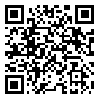BibTeX | RIS | EndNote | Medlars | ProCite | Reference Manager | RefWorks
Send citation to:
URL: http://rjms.iums.ac.ir/article-1-8612-en.html
Background & Aim: Congenital stenosis of the piriform aperture is a rare disease caused by increased growth of nasal processes of the maxillary bone, leading to a decreased nasal piriform aperture width (less than 8 to 11 mm), which can lead to respiratory obstruction-associated symptoms in patients. According to the severity of the patient's symptoms, the age of diagnosis can vary from the first weeks of life to the age of 6 years (2). The incidence rate of this disease is estimated to be about a quarter to a third of the incidence rate of choanal atresia, and these two diseases can cause similar symptoms (2). In various studies, the incidence rate of Choanal atresia has been reported between 1 in 5000 and 8000 live births (3, 4). In more than 60% of the patients with this condition, there is a single large central maxillary mega-incisor (5). The proposed theories favor that this disease is mild holoprosencephaly, and further workups are required to find possible accompanying abnormalities in these patients (6). The most common symptoms in these patients are periodic cyanosis, feeding problems, and sleep problems (7). In the axial cross-sectional CT scan of these patients, the width of each piriform aperture is less than 3 mm, and the width of both is less than eight mm (2). In mild cases, non-surgical treatment using nasal tubes and vasoconstrictor drops can be used. However, for more severe cases, surgical treatment is necessary, and the best surgical approach used to treat this disease is using a sublabial incision and drilling the bone using a diamond drill (1).
Case presentation: Our patient is a 4-month-old girl who has had symptoms of respiratory distress during feeding since birth, which once led to transient cyanosis. The patient was examined in another medical center and, due to the non-passage of the nasogastric tube, with the diagnosis of choanal atresia, underwent surgical repair. During the surgery, an attempt was made to establish an airway using dilators, which unfortunately led to septal perforation. The patient's breathing problem continued. The patient was referred to our center and underwent an examination and CT scan, and the diagnosis of congenital piriform aperture stenosis was made for her.
The patient was a candidate for surgery to repair the congenital narrowing of the entrance to the nasal cavity. The patient was prepared for surgery with the cooperation of the pediatricians and anesthesiologists. Under general anesthesia, a sublabial incision was made, preserving two millimeters of buccal mucosa, and a tissue dissection was performed in the subperiosteal plane. After dissection, the anterior nasal spine and piriform aperture could be visualized sufficiently. Then, the drill was done on both sides using a diamond drill of the proper size so that the raised mucosa was not damaged. Drilling the floor of the nasal cavity was avoided due to the possibility of damage to the roots of the teeth. Two tubes were inserted into the nasal cavities, and the patient became a candidate for septum repair at an older age. The patient was discharged from the hospital after three days without any complications. Suction and washing with normal saline solution were taught to the patient's parents. Twelve days after the surgery, the tubes placed in the nasal cavities were removed, and the patient underwent regular follow-up. No complications were observed during regular follow-ups for 6 months.
Conclusion: Congenital stenosis of the nasal piriform aperture is a rare congenital disease from the spectrum of holoprosencephalic abnormalities caused by excessive growth of the nasal processes of the maxillary bone (8). This disease may occur with different severities, and depending on the severity of the disorder or other associated anomalies, the age of disease diagnosis can vary from birth to the first decade of life (9).
The most common symptom of these patients is one- or two-sided nasal obstruction, which various diseases can cause. More prevalent than congenital piriform aperture stenosis, Choanal atresia causes similar symptoms, so there is a possibility of underdiagnosing or misdiagnosing congenital piriform aperture stenosis (2). Other diseases that cause nasal obstruction include dermoid cysts, epidermoid cysts, tumors of the nasal cavity and sinuses, abnormalities of the nasal septum, infectious causes, meningocele, and meningoencephalocele (10).
Diagnosis of this disease is mainly based on the clinical examination of the patient and the use of imaging modalities. In the clinical and endoscopic examination of the patients, the narrowing of the entrance of the nasal cavity is evident due to excessive bony growth, and the narrowing is not seen in the more posterior sections, especially in the nasopharynx area. The most accurate imaging modality is a CT scan without contrast in an axial section (2, 11).
Depending on the severity of the symptoms and the age of diagnosis, maintenance treatments such as environmental humidification, vasoconstrictor drops, or surgical treatment can be used (8). The best surgical method for these patients is to use a sublabial incision and remove the bone edge using a diamond drill (12).







